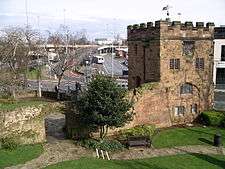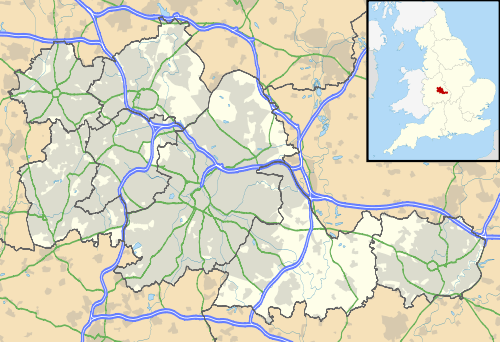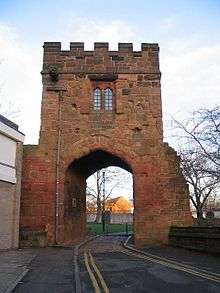Coventry city walls
Coventry's city walls are a sequence of defensive structures built around the city of Coventry in England.
| Coventry city walls | |
|---|---|
| Coventry, West Midlands | |
 Swanswell Gate | |
 Coventry city walls | |
| Coordinates | 52.41089°N 1.50795°W |
| Grid reference | grid reference SP335793 |
| Type | City wall |
| Site history | |
| Materials | Sandstone |
History
The city of Coventry was not walled until the 14th century; by the beginning of the 13th century the city was surrounded by ditches and had movable "bars" controlling access to the main routes in and out the city, but there were no proper defensive walls.[1] Reflecting Coventry's commercial and strategic importance, construction began on new city walls in the 1350s, with the mayor of Coventry, Richard Stoke , recorded as laying the first stone in 1356.[2] The construction effort started at New Gate and was initially finished in around 1400, but much repair work and re-routing was subsequently carried out to accommodate the expanding city and the walls were not finally completed until 1534.[3]

The walls measured nearly 2.2 miles (3.5 km) around and consisting of two red sandstone walls infilled with rubble over 8 feet (2.4 m) thick and 12 feet (3.7 m) high, with 32 towers including 12 gatehouses.[4] The twelve city gates were titled New Gate, Gosford Gate, Bastille Gate (later Mill Gate), Priory Gate (Swanswell Gate), Cook Street Gate, Bishop Gate, Well Street Gate, Hill Street Gate, Spon Gate, Greyfriars Gate, Cheylesmore Gate and Little Park Street Gate.[5]
The building work was paid for by murage, by which the king allowed a city to raise taxes on the imports of particular goods, and assisted by King Richard II allowing stone to be quarried from his park in Cheylesmore.[4] Later, some towers along the wall were let to private citizens, on the condition that they assisted in maintaining stretches of the defences.[6] Watchmen for the walls and gates were provided by dividing Coventry into ten wards, each of which had the task of providing a number of men on a rotating basis.[7]
With its walls, Coventry was described as being the best-defended city in England outside London.[4] The city of Coventry faced few military threats, however, and the decision to build the walls appears to have been driven by political and economic drivers - walls were important symbolically to a city's leading citizens and in turn could bring additional trade.[8] The decision to build the walls in the 1350s appears to be linked to the "Tripartite Indenture" of Coventry in 1355, which established a common local government for the city.[9]
The walls were maintained into the 17th century and were repaired during the English Civil War of the 1640s.[1] In 1662, after the restoration of the monarchy, in revenge for the support Coventry gave to the Parliamentarians during the Civil War, the city walls were demolished on the orders of King Charles II. In the 21st century only two of the medieval gates survive - Swanswell Gate[10] and Cook Street Gate[11] - and some small sections of walling.[12] The remaining wall circuit is protected as a Grade I listed building and a scheduled monument.
See also
- Scheduled Ancient Monuments in Coventry
- Grade I listed buildings in Coventry
- List of town walls in England and Wales
References
- Coventry HER MCT2599, Heritage Gateway, accessed 8 October 2011.
- Creighton and Higham, p.32.
- Fox, pp.29–30; Creigham and Higham, p.34.
- "Introduction: the building of the wall", Coventry's City Wall and Gates, retrieved 1 October 2008
- Fox, p.30.
- Creighton and Higham, p.169.
- Creighton and Higham, p.191.
- Creighton and Higham, p.87.
- Creighton and Higham, p.212.
- 52°24′39″N 1°30′28″W
- 52°24′43″N 1°30′30″W
- Creighton and Higham, p.265.
Bibliography
| Wikimedia Commons has media related to Coventry City Walls. |
- Creighton, Oliver Hamilton and Robert Higham. (2005) Medieval Town Walls: an Archaeology and Social History of Urban Defence. Stroud, UK: Tempus. ISBN 978-0-7524-1445-4.
- Fox, Levi. (1957) Coventry's Heritage. Birmingham, UK: Coventry Evening Telegraph. OCLC 9009042.